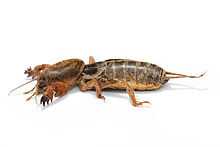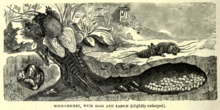Mole cricket
| Mole cricket | |
|---|---|
 | |
| Gryllotalpa brachyptera, Victoria, Australia | |
| Scientific classification | |
| Kingdom: | Animalia |
| Phylum: | Arthropoda |
| Class: | Insecta |
| Order: | Orthoptera |
| Superfamily: | Grylloidea |
| Family: | Gryllotalpidae Saussure, 1870 |
 | |
| Distribution of the 3 main genera of Gryllotalpidae | |
The mole crickets are the family Gryllotalpidae, in the order Orthoptera (grasshoppers, locusts and crickets). Mole crickets are cylindrical-bodied insects about 3–5 centimetres (1.2–2.0 in) long, with small eyes and shovel-like forelimbs highly developed for burrowing.
Description
Mole crickets vary in size and appearance, but most of them are of moderate size for an insect, typically 3-5 cm long. They are muscular, as one may verify by holding one in the hand; they are inoffensive, but the confined insect will try to dig its way out with considerable force. The abdomen is rather soft, but the head, forelimbs, and prothorax are heavily sclerotised. The hind legs are shaped somewhat like the legs of a real cricket, but are more adapted for shoving while digging, rather than leaping, which they do rarely and poorly.
Biology
Most species of mole crickets can fly powerfully, if not with agility or frequency. Usually they fly only when moving long distances, such as when changing territory, or when females are searching for singing males. The adults of some species of mole cricket may fly as far as 8 kilometres (5.0 mi) during the mating season. Mole crickets are active most of the year, but spend the winter in hibernation. Last stage juvenile insects have short wingpads where adult wings develop. Their appearance varies by species, but are universally very tubular in shape and have short, powerful digging front legs consistent with their burrowing habits. Males have forewings with a scraper that, when rubbed against a file on the other wing, produces a pulse of sound; repeating this action produces a chirp (short sequence) or trill (long sequence). Some loosely resemble grasshoppers or very large ants or dark-colored "termites" when wings are short.
Mole crickets are omnivores, feeding on larvae, worms, roots, and grasses. Common predators of mole crickets include birds, rats, skunks, armadillos, raccoons, foxes and blue ants.
Mole crickets are relatively common, but because they are nocturnal and spend nearly all their lives underground in extensive tunnel systems, they are rarely seen. Mole crickets amplify their song by chirping in a burrow that they've carefully sculpted into the shape of a double exponential horn, which acts as a megaphone.[1] They inhabit agricultural fields, lawns and golf courses. They are present in every continent with the exception of Antarctica, and are commonly considered pests. In East Asia, however, they are sometimes used as food (fried).
In some places, mole cricket numbers are declining due to soil erosion and habitat destruction.


Mole cricket genera
There are several genera of mole cricket, separated into tribes:
- tribus Gryllotalpini
- Gryllotalpa
- Gryllotalpella
- Neocurtilla
- † Pterotriamescaptor
- tribus Scapteriscini
- Indioscaptor
- Scapteriscus
- Triamescaptor
- tribus unknown (fossil taxa)
- † Archaeogryllotalpoides
- † Cratotetraspinus
- † Marchandia
- † Palaeoscapteriscops
References
- ↑ (Dawkins, The Selfish Gene, pg. 63)
See also
- Larra bicolor – parasitoid of Scapteriscus mole crickets
External links
| Wikimedia Commons has media related to Gryllotalpidae. |
| Wikispecies has information related to: Gryllotalpidae |
- Mole Cricket Knowledge Base at University of Florida / Institute of Food and Agricultural Sciences
- On the University of Florida / Institute of Food and Agricultural Sciences Featured Creatures website
| |||||||||||||||||||||||||||||||||||||||||||||||||||||||||||||||||